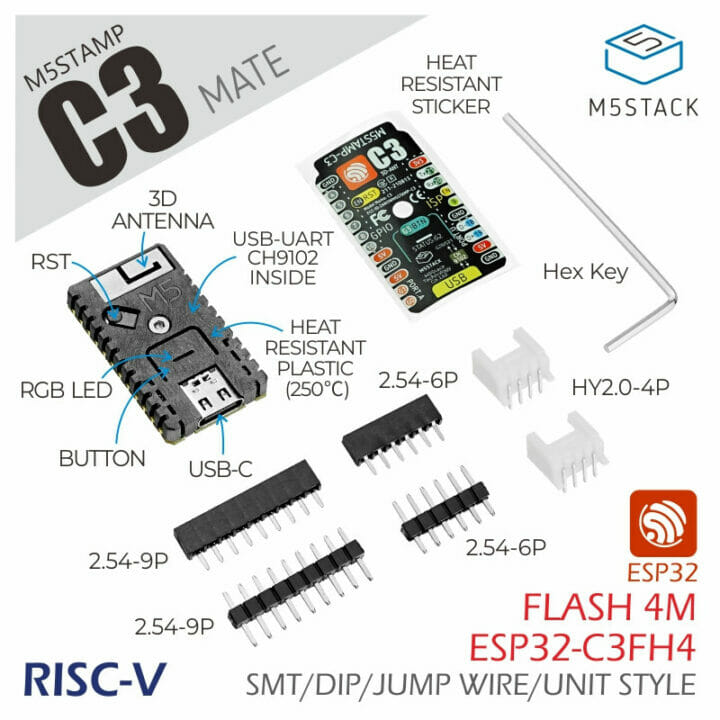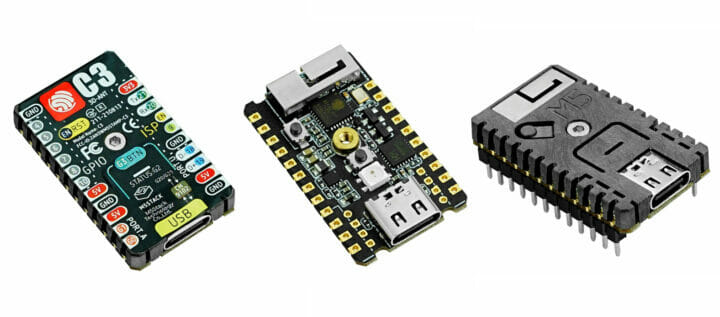It was only last month that M5Stack launched the M5Stamp Pico module based on an ESP32-PICO-D4 SiP and heat-resistant plastic shell, but M5Stamp C3 board is already out with most of the same specifications and features but an ESP32-C3 RISC-V SoC replaces the ESP32 dual-core Xtensa processor.
M5Stamp C3 offers WiFi 4 and Bluetooth 5.0 with high bitrate and long-range connectivity and comes with the same heat-resistant plastic shell, but the company also highlights the RSA-3072-based secure boot and the AES-128-XTS-based flash encryption as a more secure way to address Bluetooth security concerns.
- WiSoC – ESP32-C3FH4 32-bit single-core RISC-V processor @ up to 160 MHz, with 384KB ROM, 400KB SRAM, 8KB RTC SRAM, 4MB embedded flash, WiFI and Bluetooth
- Connectivity
- 2.4 GHz WiFi 4, 20 MHz and 40 MHz bandwidth, IEEE 802.11 b/g/n protocol, up to 150 Mbps
- Bluetooth 5, Bluetooth mesh, with supports for 125 Kbps, 500 Kbps, 1 Mbps, 2 Mbps bitrate, long-range
- 2.4G 3D Antenna
- USB – 1x USB Type-C port for power and programming via CH9102 USB to TTL chip
- Expansion – 2.54mm pitch headers with ADC, 13x GPIO, SPI, UART, I2C, I2S, PWM, RMT, DMA, USB Serial, TWAI
- Misc – 1x user button, 1x reset button, user RGB LED
- Input voltage – 5V @ 500mA via USB-C port
- Dimensions – 34 x 20 x 4.5mm
- Weight – 3.8 grams
 The Stamp-C3 is compatible with Arduino, ESP32-IDF, and other development platforms supported by ESP32-C3, but UIFlow visual programming IDE will soon be supported. Instructions to get started can be found on the documentation website. M5Stamp C3 offers more IOs than M5Stamp Pico, and the Bluetooth 5.0 implementation supports new features like Long Range and 2 Mbps bandwidth that are missing in Xtensa based ESP32 chips even though they obtained Bluetooth LE 5.0/5.1 certification last year. Another notable difference is the presence of a USB-C port that should make it easier to work with.
The Stamp-C3 is compatible with Arduino, ESP32-IDF, and other development platforms supported by ESP32-C3, but UIFlow visual programming IDE will soon be supported. Instructions to get started can be found on the documentation website. M5Stamp C3 offers more IOs than M5Stamp Pico, and the Bluetooth 5.0 implementation supports new features like Long Range and 2 Mbps bandwidth that are missing in Xtensa based ESP32 chips even though they obtained Bluetooth LE 5.0/5.1 certification last year. Another notable difference is the presence of a USB-C port that should make it easier to work with.
The board is sold in single units as part of the M5Stamp C3 Mate kit that also comes with headers, grove connectors, and a hex/Allen key. Alternatively, it is also sold as part of a pack of 5 with the board and heat-resistant plastic shell only. M5Stamp C3 Mate is sold for $6, while the bundle with 5 pieces of M5Stamp C3 goes for $28.90. You’ll find both on the M5Stack store.

Jean-Luc started CNX Software in 2010 as a part-time endeavor, before quitting his job as a software engineering manager, and starting to write daily news, and reviews full time later in 2011.
Support CNX Software! Donate via cryptocurrencies, become a Patron on Patreon, or purchase goods on Amazon or Aliexpress





